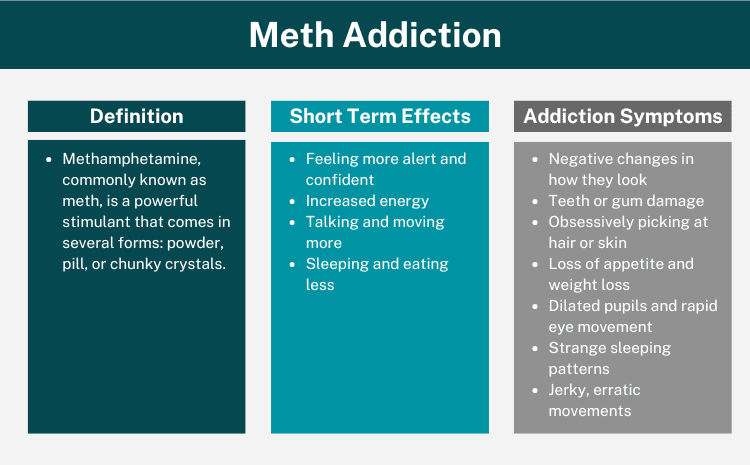Meth Addiction: Causes, Effects, and Treatment
Methamphetamine, commonly known as meth, is a powerful and highly addictive stimulant. It was first synthesized by a Japanese chemist in 1893. Initially, meth was used as a medical treatment for conditions like narcolepsy and asthma, and even as a weight-loss drug.
However, meth’s story took a dramatic turn during World War II. Both Allied and Axis forces used the drug to keep troops awake and alert. After the war, meth usage skyrocketed, leading to widespread abuse. This led to the U.S. outlawing meth in 1970.
Unfortunately, meth use has continued to increase. In 2021, around 2.5 million people aged 12 or older reported using meth in the past year. About 1.6 million of these people had a meth use disorder.
Between 2015 and 2019, arrests for meth possession went up by 59%. During the same period, the number of people with meth-related substance use disorders increased by 37%, and overdose deaths involving meth more than doubled. These numbers show just how serious the problem has become.
What Is Meth?

Methamphetamine, commonly known as meth, is a powerful stimulant that comes in several forms: powder, pill, or chunky crystals. This allows people to use meth in different ways: smoking, swallowing as a pill, crushing and snorting, or injecting. Each method affects how intense and long-lasting the effects are.
When people use meth, they feel more awake, active, and alert. It also gives them a strong sense of euphoria and excitement. This occurs because meth triggers a massive release of dopamine, a chemical in the brain that makes you feel pleasure. However, these effects come with serious downsides. Meth decreases appetite, raises blood pressure and body temperature, and causes faster, shallow breathing. Additionally, the intense and pleasurable experiences make meth a highly addictive drug that is difficult to quit.
People who use meth think it will keep them energized and alert. While it might give a temporary boost, meth is extremely damaging to both the body and brain, especially with repeated use.
What Is the Difference Between Meth and Crystal Meth?
Meth and crystal meth are terms that are often used interchangeably. However, there are key differences between these drugs.
Crystal methamphetamine, commonly known as crystal meth, is a higher-purity form of methamphetamine. This purity level produces stronger effects compared to regular meth. Crystal meth often looks like small shards of broken glass, which is why it gets street names like clear, shatter, glass, shards, and crystal.
Because of its higher purity, crystal meth results in more of the substance being absorbed into the bloodstream, even at similar doses. This leads to a greater intensity of effects and a higher risk of addiction. The increased potency also raises the likelihood of overdose and severe side effects from overstimulation.
Drugs Commonly Combined with Meth
Combining meth with other drugs can amplify its effects and increase the risks. Here are some common combinations:
Meth and Alcohol: This combination can make you feel more awake and alert, masking the effects of alcohol. As a result, you might drink more than you realize, increasing the risk of alcohol poisoning. Additionally, both substances can put a heavy strain on your heart, leading to cardiovascular problems.
Meth and Morphine: Morphine is an opioid painkiller that can slow down your breathing. When mixed with meth, the stimulant effects can overshadow the depressant effects of morphine, leading to potential overdose. This combination can cause severe respiratory issues, confusion, and an increased risk of addiction to both substances.
Meth and Xanax: Xanax is a prescription medication used to treat anxiety and panic disorders. When combined with meth, the contrasting effects can lead to unpredictable behavior and heightened anxiety. The risk of overdose also increases, as the stimulant effects of meth may cause you to take more Xanax to counteract the high, leading to dangerous levels of the drug in your system.
Effects and Risks
Short Term Effects Meth
When you use meth, you may feel a high similar to other stimulants, such as cocaine. Even with small amounts, you might experience:
- Feeling more alert and confident
- Increased energy
- Talking and moving more
- Sleeping and eating less
You may also get some physical symptoms, which can be uncomfortable, such as:
- Fast breathing
- Racing heart
- Chest pain
- Dry mouth
- Muscle tension
- Increased body temperature
In general, you may feel the effects of meth for around 2-6 hours if you smoke it or 6-8 hours if you inject it. The high may last a bit longer if you snort or swallow the drug, sometimes up to 12 hours or more. The duration can vary depending on how often you use meth.
Long Term EffectsMeth
Using meth regularly can lead to serious physical and emotional issues. These problems can affect your life in both big and small ways, including addiction. Here are some long-term effects of regular meth use:
- Significant weight loss due to not eating
- Constantly seeking out the drug
- Severe dental problems (“meth mouth”)
- Intense itching, causing sores from scratching
- Feeling like bugs are crawling under your skin
- Anxiety, depression, and other mood changes
- Confusion and trouble focusing
- Memory loss
If you use meth often, you may also:
- Use poor judgment and take risky actions
- Only feel good when using the drug
- Become aggressive and violent
- Experience extreme paranoia
- Hallucinate, seeing or feeling things that aren’t real
These long-term effects highlight the severe impact meth can have on your overall well-being.
Withdrawal from Methamphetamines
When someone goes through methamphetamine withdrawal, they often experience effects opposite to the initial drug effects. How severe the withdrawal symptoms are depends on the person, how long they used, and how much they used.
During meth withdrawal, you might have the following physical symptoms:
- Feeling very tired (you may sleep for most of the day for 2 to 4 days)
- Disturbed sleep (if you used meth for a long time, sleep patterns won’t be normal for many weeks)
- Dry mouth
- Headaches
- Feeling anxious, paranoid, or having hallucinations
- Not eating enough (malnourishment)
- Muscle spasms
You might also have these emotional symptoms, which can last for weeks or months:
- Feeling depressed or anxious
- Being paranoid
- Not feeling motivated
- Low energy levels
- Intense cravings for more meth
Symptoms Someone Is Using Meth
Are you worried someone you care about might be misusing meth? Consider these signs:
- Negative changes in how they look or care for themselves
- Teeth or gum damage
- Obsessively picking at hair or skin
- Loss of appetite and weight loss
- Dilated pupils and rapid eye movement
- Strange sleeping patterns—staying up for days or even weeks at a time
- Jerky, erratic movements; twitching; facial tics; animated or exaggerated mannerisms; and constant talking
- Borrowing money often, selling possessions, or stealing
- Angry outbursts or mood swings
- Psychotic behavior, such as paranoia and hallucinations
People who use meth may also keep drug tools or paraphernalia around, including:
- Needles or syringes
- Burnt spoons
- Surgical tubes
Meth Addiction Treatment and Recovery
As you use meth more frequently, your body develops tolerance to the drug, requiring higher doses to achieve the same effects. This cycle of increasing use can quickly spiral into meth abuse, causing significant physical and mental health issues.
The treatment for methamphetamine abuse often involves a combination of behavioral therapies. Here are some effective treatment options:
- Cognitive-behavioral therapy (CBT): CBT helps prevent relapse by increasing awareness of high-risk situations, developing coping skills, changing harmful behaviors, and managing cravings.
- Contingency management: This approach involves giving tangible rewards to reinforce positive behaviors, such as attending treatment sessions and abstaining from drug use.
- The Matrix Model: This comprehensive approach incorporates behavioral therapy, individual therapy, family therapy, education, 12-Step meetings, drug testing, and positive reinforcement.
Currently, there are no medications approved by the U.S. Food and Drug Administration (FDA) specifically for meth addiction treatment. However, medications may be prescribed to manage specific withdrawal symptoms or other issues that arise during recovery.
Looking for Help for Methamphetamine Addiction
If you or a loved one is struggling with meth addiction, seeking professional help is crucial. Meth addiction is a serious condition that often requires medical intervention and support from substance abuse professionals.
Rehab centers offer structured environments where individuals can receive comprehensive care. These facilities provide a combination of therapies, including behavioral therapy, individual counseling, group therapy, and medical support to manage withdrawal symptoms.
Remember, recovery is a journey, and seeking help is the first step towards a healthier, drug-free life. With the right treatment and support, overcoming meth addiction is possible. If you or someone you know is struggling with meth addiction, don’t hesitate to reach out for help. Your path to recovery starts with a single step.
